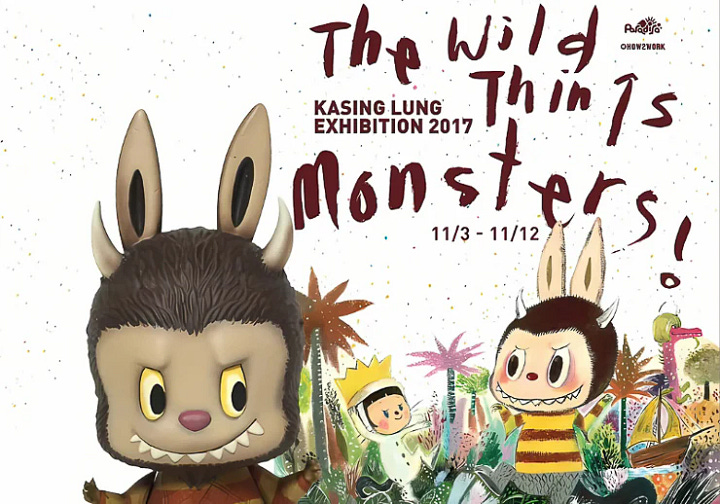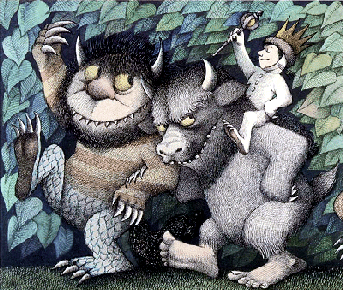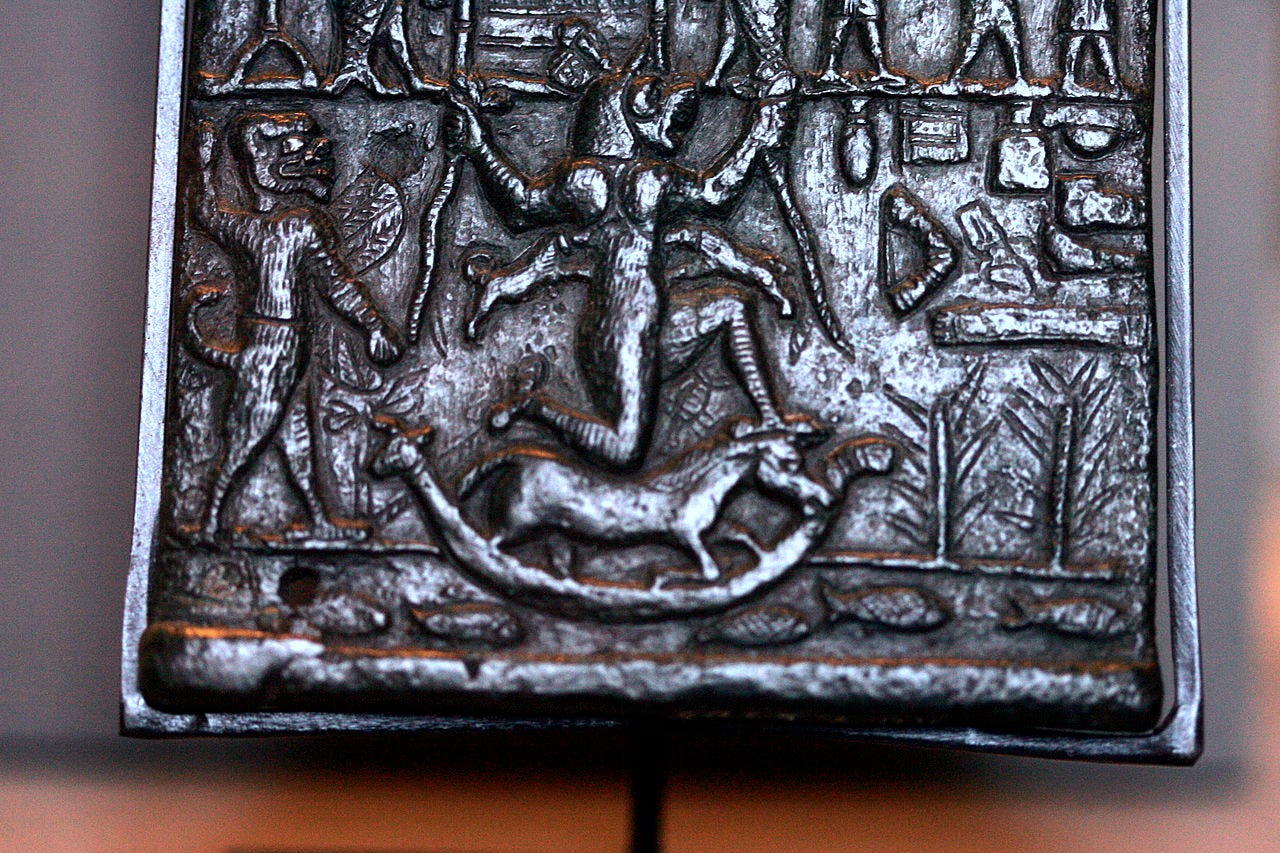I normally draft my articles well in advance but yesterday I happened to click on this piece by Evie Magazine which claims that ‘Labubu’ dolls are channelling the Mesopotamian demon Pazuzu, last seen menacing Max von Sydow in The Exorcist.
As someone who loves horror films and whose PhD traced the influence of magical traditions on English fiction, I just had to give my two pence. Don’t go and be mean to this writer, she’s entitled to her beliefs (at the time of writing Evie Magazine hasn’t actually bothered to include her name on her Substack article anyway).
What in hell are these god-awful looking Labubu dolls?
They’re the latest collectible toy, designed by a Hong Kong artist called Kasing Lung. Labubus are a tribe of mischievous monsters who live in the woods, sort of Sylvanian Families by way of Where the Wild Things Are by Maurice Sendak. Lung even did a Wild Things inspired Labubu — although I know which version I prefer.


They’re sold using a ‘blind box’ system where you order a set without knowing what’s inside. This has played a huge role in their success: buying these boxes is like buying a raffle ticket for the rush of hoping you’ll unbox your favourite character or something rare. They are perfect for compulsive collectors, and there are versions you can clip onto your designer bag as a cuddly status symbol.
All I can see when I look at these dolls is a sad mental montage of the thousands of cubic yards of landfill they’ll become like many a must-have craze or Happy Meal toy before them. But besides the ordinary problems of consumerism and environmental damage, there’s nothing unusually bad about them…right?
Demonic Energy
Although they’ve been around since 2015, the recent boom in popularity has led to a spate of conspiracy theories about Labubus channelling evil forces. Reports of children’s behaviour changing, of the dolls moving around in the night, of people getting sick in their presence and of ‘demonic energy’ emanating from them gained traction on TikTok and elsewhere.
In Erbil, Kurdistan, city officials even went so far as to ban and confiscate the dolls, although this was not, as has sometimes been reported, because of their supernatural qualities. From the Kurdistan news outlet Rudaw:
“Hogir Ali, director of Erbil’s commercial monitoring body, told Rudaw on Tuesday that the ban was prompted by widespread scams of Kurdish citizens, as merchants were reportedly exploiting customers through "blind box" sales…placing what Ali described as an “unjust burden” on families.”1
It’s interesting that, although the myth of Pazuzu comes from this region of the world (modern day Iraq), the rumour about his connection to the dolls does not seem to have started there. In fact, a sizeable portion of the online backlash has is in fact come from hardline Christian fundamentalists in the US, a group with a long history of connecting popular toys and games to occult forces trying to infiltrate the home.
Evie vs Pazuzu
The author of the Evie article explains the reasoning behind these claims:
“Labubu’s design is a paradox. It blends a childlike sense of fantasy with a grotesque, even unsettling aesthetic. While many describe it as “cute,” its wild eyes, sharp teeth, and goblin-esque grin evoke something closer to folklore tricksters than cartoon mascots. In the world of toy design, it’s brilliant. In the world of spiritual symbolism? It’s a red flag.”
It’s odd though that the article never mentions that Lung himself has openly talked about his folkloric inspirations. He spent time living in Europe and is a huge fan of the woodland elves of Norse mythology which inspired the Labubu characters. You’d think that this ‘pagan’ source material would be demonic enough for the kind of person who thinks Satan uses non-Christian characters to deceive and corrupt.
But no, the Evie article seems convinced that the ancient Mesopotamian demon Pazuzu is the spirit possessing these dolls, and it’s been fascinating to try to figure out why. The article says:
“A handful of collectors and spiritual researchers have pointed out Labubu’s uncanny resemblance to Pazuzu, an ancient Mesopotamian demon known as the “king of the demons of the wind.” In ancient lore, Pazuzu was associated with bringing famine, plague, and destructive storms…both Labubu and Pazuzu share exaggerated features: wide, manic eyes; sharp, animalistic teeth; pointed ears; and a general aura of mischief turned malevolent. The connection may seem like a stretch, until you remember that Pazuzu was often depicted smiling in ancient carvings, a trick to confuse humans about his true intentions.”
It does, indeed, seem a bit of ‘a stretch.’ Our author doesn’t mention who the ‘handful of collectors’ and ‘spiritual researchers’ are. But let’s hear her out, what exactly are the ‘true intentions’ of these deceitful dolls?
“Some people claim that their Labubus moved around the house on their own. Others claim to be suddenly struggling with insomnia. These aren’t just isolated incidents, either. Dozens of similar stories have emerged. People report sudden emotional shifts after displaying the toy; feeling drained, irritable, or plagued by anxiety. Some even describe physical symptoms: headaches, insomnia, or that stomach-churning sense of being watched.”
If you remember the fundamentalist backlash against Harry Potter, Pokémon, furbies, and other 90s children’s favourites, this might all sound strangely familiar. It also resembles the plot of a Creepypasta, a scary story designed to go viral and spark urban legends. In fact, the Evie author doesn’t seem to have noticed that one of the sources she links in that paragraph is labelled ‘horror fiction:’
The article ends with a general exhortation to reconsider buying or keeping Labubu dolls, but since I’m fascinated by the way beliefs develop and thrive it still left me wondering:
Why Pazuzu?
The article tells us that, like the dolls, ‘Pazuzu was often depicted smiling in ancient carvings, a trick to confuse humans about his true intentions.’
I hate to by a party pooper but Pazuzu doesn’t really smile in ancient artworks, he snarls because he has the head of a lion. He also doesn’t really disguise his appearance, he’s quite conspicuously terrifying, which is a crucial part of his role because he is an ‘apotropaic figure’ i.e. something that looks scary and will therefore frighten things away, like a guard dog.
Here are some more party pooping facts:
Pazuzu usually leers with his mouth open; Labubu dolls have closed mouths. Pazuzu has a long tail; most of the Labubus don’t have tails at all. Pazuzu statues often have a threateningly raised right hand; I’ve never seen one of the dolls doing this. Pazuzu is a wind spirit and is depicted with wings; Labubus don’t have wings. He is always male, often with quite a prominent erection; most of the dolls are canonically female and I think we’d have noticed by now if they had massive ding-dongs. Pazuzu doesn’t have rabbit ears and doesn’t come in pastel colours…I could go on.
So why has this Pazuzu connection emerged? I can’t say for sure but I think the following reasons might together be responsible.
1. ‘Pazuzu’ and ‘Labubu’ sound a tiny bit similar. They have the same vowels at least.
2. People have heard of Pazuzu because he’s in The Exorcist, a film in which a child innocently playing with a toy (well, a Ouija board) accidentally channels the demon into the family home.
3. There’s a Simpsons episode parodying The Exorcist where Maggie is given a Pazuzu doll and becomes possessed.
This story is called ‘The Exor-Sis’ and is from the episode ‘Treehouse of Horror XXVIII’ (if you love The Simpsons go and listen to my interview with Tyler Shores about the Treehouse series). Here, Homer accidentally orders a Pazuzu doll from Amazon because he’s trying to order pizza. It’s put in Maggie’s room and she’s soon floating down the stairs, murdering members of the community, and speaking with the voice of Harvey Fierstein.
I genuinely think that this is why American fundamentalists have decided the Labubu dolls are channelling Pazuzu, I think this is a half-remembered synopsis of The Exorcist mingled with a Simpsons episode.
Now, it’s not up to me to tell people what to believe. For all I know, there really are dangerous spirits that possess children’s toys. What irks me is not so much demonisation but lazy demonisation, especially when there’s such a wealth of folklore and mythology to draw on. You could say that Tycoco, the skeleton character, is Mictlāntēcutli the Aztec god of death. You could put a bit more effort into finding out exactly which minor Norse deities Lung was thinking of when he designed the dolls.
OR you could stick with ancient Mesopotamia and try a different demon who perhaps fits better with the dolls’ design and was far more feared than Pazuzu himself.
Pazuzu vs Lamashtu
Coincidentally, I have just been reading an excellent book called Woman’s Lore: 4,000 Years of Sirens, Serpents and Succubi by new favourite scholar Sarah Clegg which explores at length the legacy of the terrifying Lamashtu and her relationship with Pazuzu.

Lamashtu is the embodiment of one of our ancestors’ greatest fears: the death and injury associated with childbirth. She is a monstrous creature, a composite of various animals, and uses her sinister long-clawed hands to reach inside the womb itself. Clegg mentions that children had about a 35% chance of dying before adulthood and women had an 8% chance of dying in childbirth.2 Lamashtu was the spectre who was blamed for these calamities and empowering oneself against her seems to have provided a vital psychological lifeline to women entering into this vulnerable state.
Oddly enough, Pazuzu’s apotropaic qualities were enlisted precisely to combat this demoness. Clegg explores how Pazuzu’s likeness was often displayed in birthing rooms, or clutched by women in the form of an amulet, to ward off Lamashtu. She points out that Pazuzu’s role in The Exorcist is therefore a bit out of character, it should really be Lamashtu who menaces a mother and her child (she does in fact turn up in the 2023 sequel The Exorcist: Believer).
So you don’t want to say that the Labubu dolls are Pazuzu — if you look beyond The Exorcist and The Simpsons his real mythological function lies in warding off evil — you want to say that they’re Lamashtu. Hear me out: ‘Labubu’ sounds a bit like ‘Lamashtu’ and crucially it begins with the letter ‘L’ like so many of the demoness’ counterparts throughout history (Lamia, Lilith etc). The original Labubus were a female tribe, just like the Lamashtu lineage. And Lamashtu's WHOLE DEAL is harming women and children by sneaking into the house — who are the primary buyers of Labubu dolls??
You. Are. Welcome.
Where the Wild Things Are
We’ve had a fun jaunt through the world of Labubu, fundamentalist fears, and ancient demons but I’d like to end on a nicer note by returning to Maurice Sendak’s children’s classic Where the Wild Things Are.
Sendak said that the title was inspired by the Yiddish term ‘vilde chaya’ or ‘wild animals’ which was often applied to cheeky children. The monsters themselves began as caricatures of his elderly uncles and aunts whose faces seemed strangely grotesque to him as a little boy. They were Jewish immigrants who had survived extreme poverty and whose families had been murdered in the Holocaust.
He later came to realise that these same big laughing, winking, bellowing personalities with their wide eyes and toothy grins who fussed over him and pinched his cheeks were fiercely resilient and protective people shaped by trauma and survival.3 Thus he learned a vital lesson: not all monsters need to be feared.
Huge thanks this week to
who has become my latest paid subscriber. Christian has been a great supporter of my Substack and regularly features my articles in his ‘The Geekerati Newsletter’ which is always an honour. He writes about a wide variety of topics and has shared a wealth of insights into film and media. I’m always particularly intrigued to read his thoughts on roleplaying games since they’re such a fascinating branch of modern storytelling and I don’t know enough about them! His Weekly Geekly rundown is an essential review of interesting things happening on Substack and elsewhere. Do go and subscribe to him!You never quite know what will happen in my Monday articles, but if you’re interested in the history of magic, horror, theatre, storytelling and the generally weird and wonderful, consider paying to subscribe to keep me writing or like, share, comment, and recommend for free to help my substack grown. My tip jar is here— thank you!
https://www.rudaw.net/english/kurdistan/09072025
See p. 10 of Sarah Clegg, Women’s Lore: 4000 Years of Sirens, Serpents and Succubi (London: Bloomsbury, 2023).
https://www.theguardian.com/books/2011/oct/02/maurice-sendak-interview









“What irks me is not so much demonisation but lazy demonisation, especially when there’s such a wealth of folklore and mythology to draw on.”
this is a beautiful sentence and it made my day
It's Cabbage Patch dolls all over again. Some claimed they were cursed. One lady specialized in exorcising Cabbage Dolls - her story was in the Weekly Word News. I haven't been able to find a copy online, but I had the story taped to my bedroom wall for a while. Apparently, creepy dolls will always create a cult of those who believe they may be possessed. The Trilogy of Terror one was my favorite.